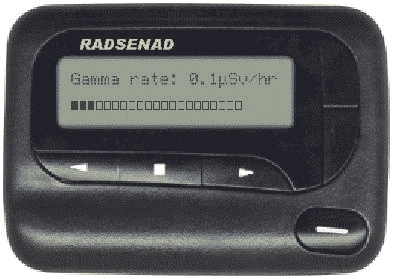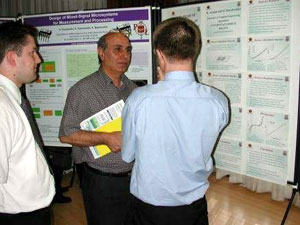| 2003 |

|
YEAR BOOK |
University of Limerick
|
Development of a personal gamma-radiation sensor using thin/thick film technologies
|

Nowadays the sterilisation process of medical products is completely automated and, once initial characterisation has been performed for a given product, total dose exposure is exclusively controlled by exposure time. Dosimeters to monitor the radiation are usually made of polymethylmethacrylate (PMMA) sheets. They cost approximately $1 each, and about 50,000 per year are used by a 10-person employee company. Their optical properties change under exposure to gamma ray radiation (g-radiation) and this gives an indirect indication of the total dose to which they have been exposed. Such dosimeters must be sent in for processing to determine the level and duration of exposure. They may only be used once and there are currently no alternatives.
Personal thermoluminescent dosimeter badges are widely used in industry and are checked on a monthly basis. Feedback is only supplied if a badge is found to indicate the exposure. Such a non-real time approach is acceptable when it is assumed that any accidental exposure would be low-level. However, today�s industry and safety precautions demand the monitoring of any change in the amount of radiation being emitted in real-time. Any alteration in the expected level should set off an alarm to prevent any exposure over the safe dose limit.
The Semiconductor Research Group at the University of Limerick, headed by Prof. Khalil Arshak, is currently working on a project that aims to develop and apply a novel cost-effective radiation sensing technology for the manufacture of dosimeters with instantaneous dosage readouts. Considerable research is underway, including efforts to enhance the sensor�s performance through both the properties of the materials and the manufacturing technologies. Detection of radiation is performed based on the fact that both electrical and optical properties of the materials undergo changes upon the influence of g-radiation. Throughout this work, oxides and organic compounds are regarded as appropriate cost-effective materials for the radiation sensing layers. So far, there is no commercially available personal g-radiation dosimeter based on the sensing properties of the oxide materials in the form of both thin and thick films.

In general, thin film devices were found to be more sensitive to lower doses of radiation than thick films. Thin film devices are therefore recommended for low-dose applications, and thick film devices for higher dose applications, as they were found to sustain higher radiation doses. However, properties of thick film devices were restored after annealing. This suggests that these films can be reused on repeatable basis. Thin film devices can hardly undergo heat treatment as diffusion of the materials occurs. To cover more than one energy or type or radiation, the approach of using devices with a combined structure can be utilised, where sections of the radiation sensor could differ in material thickness or composition. It was experimentally demonstrated that it is possible to fabricate a device that would satisfy the requirement of a particular application, such as the sensitivity to g-radiation exposure and working dose region.
Methods of research include:
|
��An Edwards E306A vacuum thermal coating system is used for thin films deposition, while DEK RS 1202 automatic screen printer is used for thick film fabrication;
��techniques for characterisation of the electrical properties of thin/thick films individually and as pn-junctions, capacitive, planar, etc., include impedance spectroscopy, I-V characteristics, Hall effect and other relevant techniques; ��the optical properties are measured using UV-VIS (UltraViolet-Visible) spectroscopy; ��structure/composition measurements techniques used: SEM (scanning electron microscopy), XRD (X-ray diffraction), FT-IR (Fourier Transform-Infra Red) Raman Spectroscopy. |
So far this project has resulted in more than 30 scientific papers in the international refereed journals and conferences all over the world.
Contact: Professor Khalil Arshak, Assistant Dean of Research, College of Informatics & Electronics, University of Limerick;
Tel: +353-61-202267; Fax: +353-61-338176;
E-mail: [email protected]